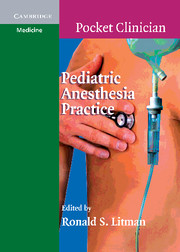Book contents
- Frontmatter
- Contents
- Preface
- PART ONE COEXISTING DISEASES
- PART TWO SURGICAL PROCEDURES
- Anterior Spinal Fusion to Cystic Hygroma (Lymphatic Malformation) Excision
- Dental Extractions & Rehabilitation to Kidney Transplant
- Lacrimal Duct Probing & Irrigation to Pyloromyotomy
- Radiotherapy to Wilms' Tumor Excision
- PART THREE REGIONAL ANESTHESIA
Anterior Spinal Fusion to Cystic Hygroma (Lymphatic Malformation) Excision
from PART TWO - SURGICAL PROCEDURES
Published online by Cambridge University Press: 10 November 2010
- Frontmatter
- Contents
- Preface
- PART ONE COEXISTING DISEASES
- PART TWO SURGICAL PROCEDURES
- Anterior Spinal Fusion to Cystic Hygroma (Lymphatic Malformation) Excision
- Dental Extractions & Rehabilitation to Kidney Transplant
- Lacrimal Duct Probing & Irrigation to Pyloromyotomy
- Radiotherapy to Wilms' Tumor Excision
- PART THREE REGIONAL ANESTHESIA
Summary
COEXISTING DISEASE
▪ Congenital: vertebral anomalies, rib anomalies, spinal dysraphism (neural tube defects)
▪ Idiopathic: infantile (<3 years), juvenile (3–10 years), adolescent (>10 years)
▪ Neuromuscular disease: CP, polio, myopathies, syringomyelia, Friedrich's ataxia
▪ Associated syndromes: neurofibromatosis, Marfan's, osteogenesis imperfecta, JRA, mucopolysaccharidosis
▪ Neoplastic: primary or secondary disease
▪ Cardiac: hypertension (enlarged RV, RV Failure), mitral valve prolapse (25%)
▪ Pulmonary: tachypnea, wheezing, crackles – symptoms when Cobb angle >65°
PREOPERATIVE ASSESSMENT
▪ Determine location & degree of curvature (Cobb's angle), etiology of disease, exercise tolerance, respiratory symptoms, co-existing disease
▪ Neurologic: document deficits
▪ ECG, ECHO – assess structural disease, RV, pulmonary pressures
▪ Pulmonary function testing, CXR, ABG if severe
▪ Labs: CBC, coags, lytes, type & cross, autologous donations
PROCEDURAL CONSIDERATIONS
▪ Location dictates position & approach.
▪ Cervicothoracic (T1-T3): supine, possible removal of clavicle, manubrium & 1st rib
▪ Endangers great vessels, thoracic duct, nerves (brachial plexus, sympathetic chain, vagus, phrenic), esophagus, trachea, heart & lungs
▪ Requires one lung ventilation
▪ Blood loss may be rapid & large.
▪ Thoracic (T5–10): lateral decub, thoracotomy, DLT helpful
▪ Transdiaphragmatic (T10–12): approach may be retroperitoneal & transthoracic
▪ Lumbar: combined with posterior repair or as part of 2-stage repair
▪ Lateral decub retroperitoneal, or supine transperitoneal
ANESTHETIC PLAN
▪ Induction: dictated by patients clinical condition
▪ NMB: short acting agent to enable neuromonitoring
▪ Maintenance: TIVA, suggest propofol, remifentanil
▪ Monitoring: std + A-line +/-central line
[…]
- Type
- Chapter
- Information
- Pediatric Anesthesia Practice , pp. 50 - 95Publisher: Cambridge University PressPrint publication year: 2007

